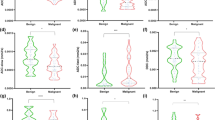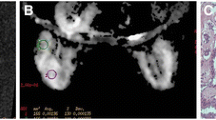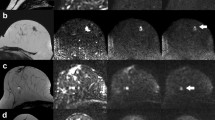Abstract
Diffusion kurtosis imaging (DKI) is a diffusion-weighted MRI technique that probes the non-Gaussian diffusion of water molecules within biological tissues. The purpose of this study was to investigate the DKI model optimal b-values combinations in invasive ductal carcinoma (IDC) versus ductal carcinoma in situ (DCIS) breast lesions. The study included 114 malignant breast lesions (64 IDC and 50 DCIS). Patients underwent a breast MRI examination which included a diffusion-weighted sequence (b = 0–3000 s/mm2). For each lesion, the b-values were combined among each other (109 combinations) and each mean kurtosis (MK) parameter was obtained. Differences between the lesion groups and b-values combinations were assessed. Also, the diagnostic performance of the combinations was determined through receiver operating characteristic (ROC) curve analysis, and compared. Root mean square error (RMSE) was also obtained. All the b-values combinations showed significant differences between the lesion groups (p < 0.05). The combination 0, 50, 200, 750, 1000, 2000 s/mm2 showed the best performance (AUC = 0.930, sensitivity = 95.3%, specificity = 82.0%, accuracy = 89.5%), with a RMSE of 17.65. The b-values combinations with the worst performance were composed of only high or ultra-high b-values, or with b = 1000 s/mm2 as the maximum b-value. Better results were obtained when zero b-value was included in the DKI model fitting with at least one b-value below 1000 s/mm2 and one b-value above 1000 s/mm2 (conserving b = 1000 s/mm2). Six was the optimal number of b-values, nonetheless other combinations with less b-values may be considered, but with a consequent diagnostic performance loss.




Similar content being viewed by others
References
Jensen JH, Helpern JA (2010) MRI quantification of non-Gaussian water diffusion by kurtosis analysis. NMR Biomed 23:698–710. https://doi.org/10.1002/nbm.1518
Jensen JH, Helpern JA, Ramani A et al (2005) Diffusional kurtosis imaging: the quantification of non-gaussian water diffusion by means of magnetic resonance imaging. Magn Reson Med 53:1432–1440. https://doi.org/10.1002/mrm.20508
Rosenkrantz AB, Padhani AR, Chenevert TL et al (2015) Body diffusion kurtosis imaging: basic principles, applications, and considerations for clinical practice. J Magn Reson Imaging 42:1190–1202. https://doi.org/10.1002/jmri.24985
Yan X, Zhou M, Ying L et al (2013) Evaluation of optimized b-value sampling schemas for diffusion kurtosis imaging with an application to stroke patient data. Comput Med Imaging Graph 37:272–280. https://doi.org/10.1016/j.compmedimag.2013.04.007
Yablonskiy DA, Sukstanskii AL (2010) Theoretical models of the diffusion weighted MR signal. NMR Biomed 23:661–681. https://doi.org/10.1002/nbm.1520
Wu EX, Cheung MM (2010) MR diffusion kurtosis imaging for neural tissue characterization. NMR Biomed 23:836–848. https://doi.org/10.1002/nbm.1506
Goshima S, Kanematsu M, Noda Y et al (2015) Diffusion kurtosis imaging to assess response to treatment in hypervascular hepatocellular carcinoma. Am J Roentgenol 204:W543–W549. https://doi.org/10.2214/AJR.14.13235
Filli L, Wurnig M, Nanz D et al (2014) Whole-body diffusion kurtosis imaging. Invest Radiol 49:773–778. https://doi.org/10.1097/RLI.0000000000000082
Marrale M, Collura G, Brai M et al (2016) Physics, techniques and review of neuroradiological applications of diffusion kurtosis imaging (DKI). Clin Neuroradiol 26:391–403. https://doi.org/10.1007/s00062-015-0469-9
Budjan J, Sauter EA, Zoellner FG et al (2018) Diffusion kurtosis imaging of the liver at 3 Tesla: in vivo comparison to standard diffusion-weighted imaging. Acta radiol 59:18–25. https://doi.org/10.1177/0284185117706608
Li HM, Zhao SH, Qiang JW et al (2017) Diffusion kurtosis imaging for differentiating borderline from malignant epithelial ovarian tumors: a correlation with Ki-67 expression. J Magn Reson Imaging 46:1499–1506. https://doi.org/10.1002/jmri.25696
Rosenkrantz AB, Sigmund EE, Johnson G et al (2012) Prostate cancer: feasibility and preliminary experience of a diffusional kurtosis model for detection and assessment of aggressiveness of peripheral zone cancer. Radiology 264:126–135. https://doi.org/10.1148/radiol.12112290
Pentang G, Lanzman RS, Heusch P et al (2014) Diffusion kurtosis imaging of the human kidney: a feasibility study. Magn Reson Imaging 32:413–420. https://doi.org/10.1016/j.mri.2014.01.006
Suo S, Chen X, Ji X et al (2015) Investigation of the non-gaussian water diffusion properties in bladder cancer using diffusion kurtosis imaging: a preliminary study. J Comput Assist Tomogr 39:281–285. https://doi.org/10.1097/.0000000000000197
Cui Y, Yang X, Du X et al (2017) Whole-tumour diffusion kurtosis MR imaging histogram analysis of rectal adenocarcinoma: Correlation with clinical pathologic prognostic factors. Eur Radiol. https://doi.org/10.1007/s00330-017-5094-3
Huang L, Li X, Huang S et al (2017) Diffusion kurtosis MRI versus conventional diffusion-weighted imaging for evaluating inflammatory activity in Crohn’s disease. J Magn Reson Imaging. https://doi.org/10.1002/jmri.25768
Borlinhas F, Lacerda L, Andrade A, Ferreira HA (2012) Diffusional kurtosis as a biomarker of breast tumors—C-1369. European Congress of Radiology. European Society of Radiology, Wien, Austria, pp 1–20. https://doi.org/10.1594/ecr2012/C-1369
Borlinhas F (2012) Quantificação da Difusão na Ressonância Magnética da mama—ADC e Kurtosis. Escola Superior de Tecnologia da Saúde de Lisboa (ESTESL). http://hdl.handle.net/10400.21/1728. Accessed 20 Setembro 2018
Wu D, Li G, Zhang J et al (2014) Characterization of breast tumors using diffusion kurtosis imaging (DKI). PLoS ONE 9:e113240. https://doi.org/10.1371/journal.pone.0113240
Nogueira L, Brandão S, Matos E et al (2014) Application of the diffusion kurtosis model for the study of breast lesions. Eur Radiol 24:1197–1203. https://doi.org/10.1007/s00330-014-3146-5
Bickelhaupt S, Jaeger PF, Laun FB et al (2018) Radiomics based on adapted diffusion kurtosis imaging helps to clarify most mammographic findings suspicious for cancer. Radiology. https://doi.org/10.1148/radiol.2017170273
Sun K, Chen X, Chai W et al (2015) Breast cancer: diffusion kurtosis MR imaging—diagnostic accuracy and correlation with clinical-pathologic factors. Radiology 277:46–55. https://doi.org/10.1148/radiol.15141625
Christou A, Ghiatas A, Priovolos D et al (2017) Accuracy of diffusion kurtosis imaging in characterization of breast lesions. Br J Radiol 90:20160873. https://doi.org/10.1259/bjr.20160873
Huang Y, Lin Y, Hu W et al (2018) Diffusion kurtosis at 3.0T as an in vivo imaging marker for breast cancer characterization: correlation with prognostic factors. J Magn Reson Imaging. https://doi.org/10.1002/jmri.26249
Woodhams R, Ramadan S, Stanwell P et al (2011) Diffusion-weighted imaging of the breast: principles and clinical applications. RadioGraphics 31:1059–1084. https://doi.org/10.1148/rg.314105160
Le Bihan D (2013) Apparent diffusion coefficient and beyond: what diffusion MR imaging can tell us about tissue structure. Radiology 268:318–322. https://doi.org/10.1148/radiol.13130420
Partridge SC, McDonald ES (2013) Diffusion weighted MRI of the breast: protocol optimization, guidelines for interpretation, and potential clinical applications. Magn Reson Imaging Clin N Am 21:601–624. https://doi.org/10.1016/j.mric.2013.04.007
Poot DHJ, den Dekker AJ, Achten E et al (2010) Optimal experimental design for diffusion kurtosis imaging. IEEE Trans Med Imaging 29:819–829. https://doi.org/10.1109/TMI.2009.2037915
Chuhutin A, Hansen B, Jespersen SN (2017) Precision and accuracy of diffusion kurtosis estimation and the influence of b-value selection. NMR Biomed 30:1–14. https://doi.org/10.1002/nbm.3777
Padhani AR, Liu G, Mu-Koh D et al (2009) Diffusion-weighted magnetic resonance imaging as a cancer biomarker: consensus and recommendations. Neoplasia 11:102–125. https://doi.org/10.1593/neo.81328
Fukunaga I, Hori M, Masutani Y et al (2013) Effects of diffusional kurtosis imaging parameters on diffusion quantification. Radiol Phys Technol 6:343–348. https://doi.org/10.1007/s12194-013-0206-5
Koh DM, Collins DJ, Orton MR (2011) Intravoxel incoherent motion in body diffusion-weighted MRI: reality and challenges. Am J Roentgenol 196:1351–1361. https://doi.org/10.2214/AJR.10.5515
Chou M-C, Ko C-W, Chiu Y-H et al (2017) Effects of B value on quantification of rapid diffusion kurtosis imaging in normal and acute ischemic brain tissues. J Comput Assist Tomogr 41:868–876. https://doi.org/10.1097/RCT.0000000000000621
Yokosawa S, Sasaki M, Bito Y et al (2015) Optimization of scan parameters to reduce acquisition time for diffusion kurtosis imaging at 1.5 T. Magn Reson Med Sci 15:41–48. https://doi.org/10.2463/mrms.2014-0139
Mazzoni LN, Lucarini S, Chiti S et al (2014) Diffusion-weighted signal models in healthy and cancerous peripheral prostate tissues: comparison of outcomes obtained at different b-values. J Magn Reson Imaging 39:512–518. https://doi.org/10.1002/jmri.24184
Merisaari H, Toivonen J, Pesola M et al (2015) Diffusion-weighted imaging of prostate cancer: effect of b-value distribution on repeatability and cancer characterization. Magn Reson Imaging 33:1212–1218. https://doi.org/10.1016/j.mri.2015.07.004
Merisaari H, Jambor I (2015) Optimization of b-value distribution for four mathematical models of prostate cancer diffusion-weighted imaging using b-values up to 2000 s/mm2: simulation and repeatability study. Magn Reson Med 73:1954–1969. https://doi.org/10.1002/mrm.25310
Association of Breast Surgery at BASO (2009) Surgical guidelines for the management of breast cancer. Eur J Surg Oncol 35:S1–S22. https://doi.org/10.1016/j.ejso.2009.01.008
Li T, Yu T, Li L et al (2018) Use of diffusion kurtosis imaging and quantitative dynamic contrast-enhanced MRI for the differentiation of breast tumors. J Magn Reson Imaging 48:1358–1366. https://doi.org/10.1002/jmri.26059
DeLong ER, DeLong DM, Clarke-Pearson DL (1988) Comparing the areas under two or more correlated receiver operating characteristic curves: a nonparametric approach. Biometrics 44:837–845
Hu F, Tang W, Sun Y et al (2017) The value of diffusion kurtosis imaging in assessing pathological complete response to neoadjuvant chemoradiation therapy in rectal cancer: a comparison with conventional diffusion-weighted imaging. Oncotarget 8:75597–75606. https://doi.org/10.18632/oncotarget.17491
Borlinhas F, Nogueira L, Brandão S, et al (2015) Diffusion kurtosis breast imaging model—which should be the highest b-value? In: ISMRM 24th annual meeting—2015, proceedings of the International Society for Magnetic Resonance, 24. Singapore, p 3017
Lu H, Jensen JH, Ramani A, Helpern JA (2006) Three-dimensional characterization of non-gaussian water diffusion in humans using diffusion kurtosis imaging. NMR Biomed 19:236–247. https://doi.org/10.1002/nbm.1020
Partridge SC, Nissan N, Rahbar H et al (2017) Diffusion-weighted breast MRI: clinical applications and emerging techniques. J Magn Reson Imaging 45:337–355. https://doi.org/10.1002/jmri.25479
Acknowledgements
This paper is supported by Fundação para a Ciência e a Tecnologia – FCT / MEC (PIDDAC) – under the Strategic Programme UID/BIO/00645/2013. The authors thank the participants of this study, and the Radiology Department staff of Instituto Português de Oncologia de Lisboa Francisco Gentil, E.P.E., Lisboa, Portugal, involved in this study. The authors also thank Nuno Loução for assistance with the MRI sequence.
Author information
Authors and Affiliations
Corresponding author
Ethics declarations
Conflicts of interest
The authors declare that they have no conflict of interest.
Ethical approval
All procedures performed in studies involving human participants were in accordance with the ethical standards of the institutional and/or national research committee and with the 1964 Helsinki declaration and its later amendments or comparable ethical standards. This article does not contain any studies with animals performed by any of the authors.
Informed consent
Informed consent was obtained from all individual participants included in the study.
Additional information
Publisher's Note
Springer Nature remains neutral with regard to jurisdictional claims in published maps and institutional affiliations.
Appendix
Appendix
See Table 4.
Rights and permissions
About this article
Cite this article
Borlinhas, F., Conceição, R.C. & Ferreira, H.A. Optimal b-values for diffusion kurtosis imaging in invasive ductal carcinoma versus ductal carcinoma in situ breast lesions. Australas Phys Eng Sci Med 42, 871–885 (2019). https://doi.org/10.1007/s13246-019-00773-2
Received:
Accepted:
Published:
Issue Date:
DOI: https://doi.org/10.1007/s13246-019-00773-2




